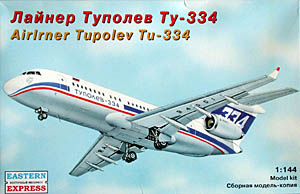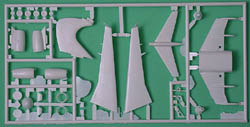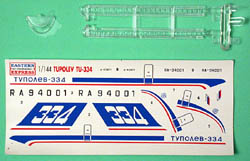Eastern Express 1/144 Tupelov Tu-334
By Chris Banyai-Riepl
 |

 |
 Construction is quite simple and follows most other airliner kits out there. The instructions make no mention of adding weight to the nose, and while this kit might not need any I would place a bit in there just to be sure. While the cabin windows are included in clear plastic, a quick test fit shows that a bit of work is needed to get them to fit just right. If you are more of a decal window type of modeler, I would recommend relying on your usual window-filling technique instead of using the clear parts. The windscreen also needs a bit of work to get to fit right, but after a bit of sanding, a snug fit should result. The nose radome is molded as a separate piece, thus saving you from the potential of sanding off the raised strips while fixing fuselage seams.
Construction is quite simple and follows most other airliner kits out there. The instructions make no mention of adding weight to the nose, and while this kit might not need any I would place a bit in there just to be sure. While the cabin windows are included in clear plastic, a quick test fit shows that a bit of work is needed to get them to fit just right. If you are more of a decal window type of modeler, I would recommend relying on your usual window-filling technique instead of using the clear parts. The windscreen also needs a bit of work to get to fit right, but after a bit of sanding, a snug fit should result. The nose radome is molded as a separate piece, thus saving you from the potential of sanding off the raised strips while fixing fuselage seams. the entire upper wing half and the winglets. The trailing edges could use a bit of thinning down, but they won’t need much. The panel lines, like those found throughout the rest of the kit, are recessed, but you will want to run over them with a scriber to even them out and also make them a bit deeper so they won’t disappear under primer. The tailplanes are molded as one piece and also include the top of the vertical fin.
the entire upper wing half and the winglets. The trailing edges could use a bit of thinning down, but they won’t need much. The panel lines, like those found throughout the rest of the kit, are recessed, but you will want to run over them with a scriber to even them out and also make them a bit deeper so they won’t disappear under primer. The tailplanes are molded as one piece and also include the top of the vertical fin. The landing gear is fairly simple in this kit, but then again it’s fairly simple in real life. There are pairs of wheels for all three struts and once in place and on the plane there really isn’t too much to add here. The gear does a great job of capturing the low stance of this plane. The wheel doors are a bit thick and probably could be replaced with thin plastic card or even brass. This is true for just about any 1/144 airliner kit, though.
The landing gear is fairly simple in this kit, but then again it’s fairly simple in real life. There are pairs of wheels for all three struts and once in place and on the plane there really isn’t too much to add here. The gear does a great job of capturing the low stance of this plane. The wheel doors are a bit thick and probably could be replaced with thin plastic card or even brass. This is true for just about any 1/144 airliner kit, though.